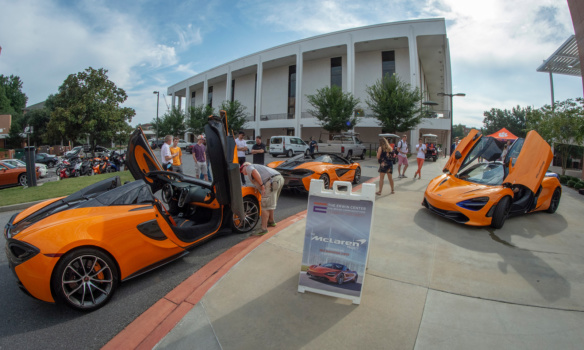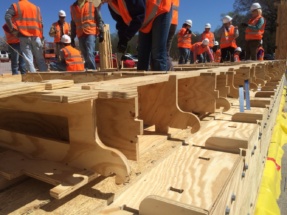McLaren puts students in driver’s seat of Erwin Center project
The next best thing to gripping the steering wheel of a high-end sports car is having a hand in marketing one of the world’s most elite brands of high-performance vehicles.

Just ask Clemson University seniors Brett Miles and Sky Williams, who have served in internships with United Kingdom-based McLaren Automotive, a manufacturer of sleek sports cars whose price tags range from $200,000 into the millions.
McLaren executives were on campus last week with three of their most popular street-designed vehicles to kick off a semester-long Creative Inquiry with The Erwin Center for Brand Communications in the College of Business. Brett and Sky are two of about 20 Clemson students who will be working with McLaren this fall on a branding initiative that aims to put more “lifestyle” sports car prospects behind the wheel of the company’s Sports Series cars.
Under the direction of Katie Hildebrand, executive director of The Erwin Center for Brand Communications, The McLaren Project is tasking students with developing a brand marketing campaign to capture a new set of consumers for the McLaren brand. Unlike “petrolheads,” who are more serious sports car enthusiasts, “lifestyle” buyers have the financial wherewithal and desire to also drive a McLaren, but without the intensity of a petrolhead.
“The McLaren Project is a perfect fit for the Erwin Center and our students,” Hildebrand said. “We pride ourselves on exposing students to real-time, real-life client challenges and this Creative Inquiry with an iconic brand like McLaren does just that. We are fortunate to have a partner like McLaren on this project, which helps position our students to step straight from the classroom to being business ready upon graduation.”

The McLaren capstone course is one of a myriad of experiential learning opportunities the College of Business makes available to students. Through capstone projects like The McLaren Project, job shadowing, lunch and learns, and the Student Enrichment opportunities in domestic and international internships, and the Tiger Ties Mentorship Program, College of Business students are well-equipped to enter the workforce.
The Erwin Center-McLaren partnership joins a similar College of Business Creative Inquiry class that has Department of Marketing students working with another multi-national company, Siemens U.S. Energy Management Division in Atlanta. Siemens is challenging students with helping it transfer knowledge from a departing baby boomer workforce to the next generation of Siemens employees. That experiential learning opportunity is in its second year and was made possible through an alum, Kevin Yates ’94, division president.
“This classroom without walls approach to learning is a hallmark of the College of Business and Clemson University,” said Wendy York, business school dean. “Whether it’s a Creative Inquiry like The McLaren Project, an internship or another one of our many experiential learning opportunities, it is another reason why Clemson-educated students are prepared to hit the ground running when they enter the business world.”
 Brett, a senior communications major, said his internship with McLaren last summer, and the capstone course are allowing students like him to get experience in taking on real-world business challenges and giving them an edge in the job market.
Brett, a senior communications major, said his internship with McLaren last summer, and the capstone course are allowing students like him to get experience in taking on real-world business challenges and giving them an edge in the job market.
“The Erwin Center is really opening doors for students on a project like this. It’s a real-time, hands-on experience. There aren’t many universities that give students full rein in building a project for a major brand with responsibility like this.”
And then there’s the wow factor.
“I’ve always had a passion for cars,” Brett added. “Once you see one of the McLarens up close, you know they’re special. The look, sound and feel of being in one makes you quickly understand why they are at the pinnacle of the high-performance car industry.”
The McLaren opportunity came to Clemson and The Erwin Center for Brand Communications by way of another alum, Andy Thomas, a 1990 mechanical engineering graduate, and McLaren’s North American vice president of marketing. Thomas was on campus to brief students on their assignment, and to introduce them to the vehicles they are helping McLaren promote by putting students in the passenger seats of the vehicles, which put out between 560 and 710 horsepower.
Thomas said students bring a valuable and unique perspective to the challenge McLaren is presenting through the capstone course.
“Students bring a clarity of thought and ideas to a project like this. They’re unencumbered by day-to-day business distractions and because of the era in which they grew up, they are savvy about knowing how to reach people through many different channels,” Thomas said. “Secondly, unlike an agency conducting this piece of work, students are able to look at the Creative Inquiry from a totally different point of view. The students are able to give it their complete focus and with that comes original ideas we may not see from our level within the industry.”
Like Brett, Sky, a sports communications and Spanish major, interned at McLaren’s headquarters in New York City and reported to Thomas. She said that experience two summers ago whetted her appetite for being part of the Erwin Center project this semester.
“I’m involved with this class because it’s McLaren and it’s under Andy’s direction. There’s a tremendous wow factor to being connected with a brand like McLaren. Taking on an elite brand’s challenge isn’t something that’s easily taught out of a textbook,” she said. “It will be a great test of what we’ve learned in the classroom, not to mention what doors it might open for us with this experience on our resumes.”
Thomas said another advantage students bring to the table on a project like this is their diverse educational backgrounds.
“One of the powers of the Erwin Center is that we’re pulling in students from across many of the university’s disciplines. With that we are bringing in students who are able to look at this challenge from very different perspectives.”
In an average academic year at Clemson, about 400 Creative Inquiry projects are ongoing that involve about 3,500 students. The primarily undergraduate class research program’s projects are generally funded by state money, but some do receive private money from companies.

Clemson University students check out three McLaren sports cars – a 720 and two 570’s – next to the Watt Family Innovation Center, Sept. 6, 2018.
Barbara Speziale, director of Creative Inquiry and professor of biological sciences, said the McLaren and Siemens projects have far-reaching benefits for students.
“Students are inspired to do their best work in these classes. When they know they’re working for a larger good, they take a different attitude,” she said. “It also benefits these smart, young minds by making these companies aware of their talents. It’s opened doors for many of our students.”
Thomas, who is an Erwin Center board member, said McLaren’s involvement is just one way a business person like himself can help the next generation of Clemson graduates.
“I’m not able to build a building on campus, but I am in a position to give back through a project like this. Being able to offer a real-world learning experience through a respected and successful brand like ours, is great for the students, the university, and McLaren.”
Dean York said corporate partnerships like those with McLaren and Siemens are invaluable to the University, and give Clemson students an edge by taking their learning beyond the classroom.
“The number of our alums who give back in this way is something that sets Clemson apart from many of our counterparts. These learning-by-doing opportunities in a professional setting and under the guidance of one of our successful graduates, bridges the gap between theory and practice. And, it puts our students in a great position for future employment.”

